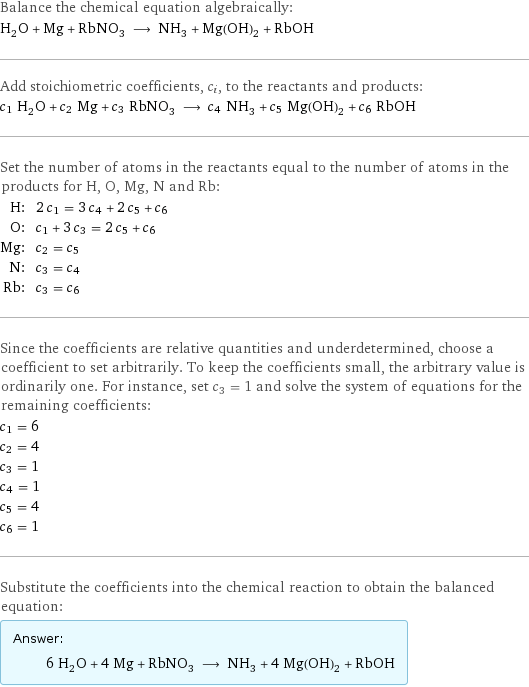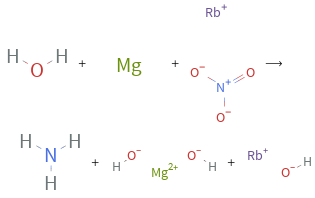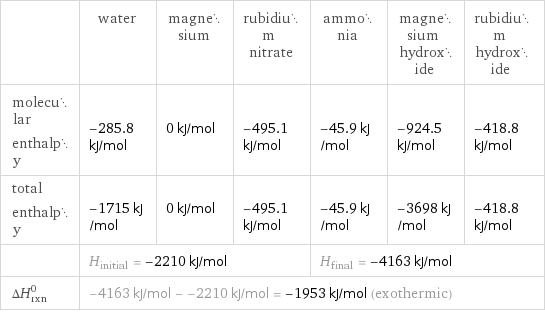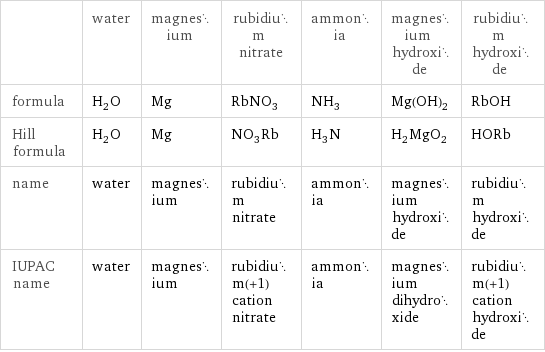Input interpretation

H_2O water + Mg magnesium + RbNO_3 rubidium nitrate ⟶ NH_3 ammonia + Mg(OH)_2 magnesium hydroxide + RbOH rubidium hydroxide
Balanced equation

Balance the chemical equation algebraically: H_2O + Mg + RbNO_3 ⟶ NH_3 + Mg(OH)_2 + RbOH Add stoichiometric coefficients, c_i, to the reactants and products: c_1 H_2O + c_2 Mg + c_3 RbNO_3 ⟶ c_4 NH_3 + c_5 Mg(OH)_2 + c_6 RbOH Set the number of atoms in the reactants equal to the number of atoms in the products for H, O, Mg, N and Rb: H: | 2 c_1 = 3 c_4 + 2 c_5 + c_6 O: | c_1 + 3 c_3 = 2 c_5 + c_6 Mg: | c_2 = c_5 N: | c_3 = c_4 Rb: | c_3 = c_6 Since the coefficients are relative quantities and underdetermined, choose a coefficient to set arbitrarily. To keep the coefficients small, the arbitrary value is ordinarily one. For instance, set c_3 = 1 and solve the system of equations for the remaining coefficients: c_1 = 6 c_2 = 4 c_3 = 1 c_4 = 1 c_5 = 4 c_6 = 1 Substitute the coefficients into the chemical reaction to obtain the balanced equation: Answer: | | 6 H_2O + 4 Mg + RbNO_3 ⟶ NH_3 + 4 Mg(OH)_2 + RbOH
Structures

+ + ⟶ + +
Names

water + magnesium + rubidium nitrate ⟶ ammonia + magnesium hydroxide + rubidium hydroxide
Reaction thermodynamics
Enthalpy

| water | magnesium | rubidium nitrate | ammonia | magnesium hydroxide | rubidium hydroxide molecular enthalpy | -285.8 kJ/mol | 0 kJ/mol | -495.1 kJ/mol | -45.9 kJ/mol | -924.5 kJ/mol | -418.8 kJ/mol total enthalpy | -1715 kJ/mol | 0 kJ/mol | -495.1 kJ/mol | -45.9 kJ/mol | -3698 kJ/mol | -418.8 kJ/mol | H_initial = -2210 kJ/mol | | | H_final = -4163 kJ/mol | | ΔH_rxn^0 | -4163 kJ/mol - -2210 kJ/mol = -1953 kJ/mol (exothermic) | | | | |
Equilibrium constant
![Construct the equilibrium constant, K, expression for: H_2O + Mg + RbNO_3 ⟶ NH_3 + Mg(OH)_2 + RbOH Plan: • Balance the chemical equation. • Determine the stoichiometric numbers. • Assemble the activity expression for each chemical species. • Use the activity expressions to build the equilibrium constant expression. Write the balanced chemical equation: 6 H_2O + 4 Mg + RbNO_3 ⟶ NH_3 + 4 Mg(OH)_2 + RbOH Assign stoichiometric numbers, ν_i, using the stoichiometric coefficients, c_i, from the balanced chemical equation in the following manner: ν_i = -c_i for reactants and ν_i = c_i for products: chemical species | c_i | ν_i H_2O | 6 | -6 Mg | 4 | -4 RbNO_3 | 1 | -1 NH_3 | 1 | 1 Mg(OH)_2 | 4 | 4 RbOH | 1 | 1 Assemble the activity expressions accounting for the state of matter and ν_i: chemical species | c_i | ν_i | activity expression H_2O | 6 | -6 | ([H2O])^(-6) Mg | 4 | -4 | ([Mg])^(-4) RbNO_3 | 1 | -1 | ([RbNO3])^(-1) NH_3 | 1 | 1 | [NH3] Mg(OH)_2 | 4 | 4 | ([Mg(OH)2])^4 RbOH | 1 | 1 | [RbOH] The equilibrium constant symbol in the concentration basis is: K_c Mulitply the activity expressions to arrive at the K_c expression: Answer: | | K_c = ([H2O])^(-6) ([Mg])^(-4) ([RbNO3])^(-1) [NH3] ([Mg(OH)2])^4 [RbOH] = ([NH3] ([Mg(OH)2])^4 [RbOH])/(([H2O])^6 ([Mg])^4 [RbNO3])](../image_source/8e4807a42bd95ddaecd51b529d316d75.png)
Construct the equilibrium constant, K, expression for: H_2O + Mg + RbNO_3 ⟶ NH_3 + Mg(OH)_2 + RbOH Plan: • Balance the chemical equation. • Determine the stoichiometric numbers. • Assemble the activity expression for each chemical species. • Use the activity expressions to build the equilibrium constant expression. Write the balanced chemical equation: 6 H_2O + 4 Mg + RbNO_3 ⟶ NH_3 + 4 Mg(OH)_2 + RbOH Assign stoichiometric numbers, ν_i, using the stoichiometric coefficients, c_i, from the balanced chemical equation in the following manner: ν_i = -c_i for reactants and ν_i = c_i for products: chemical species | c_i | ν_i H_2O | 6 | -6 Mg | 4 | -4 RbNO_3 | 1 | -1 NH_3 | 1 | 1 Mg(OH)_2 | 4 | 4 RbOH | 1 | 1 Assemble the activity expressions accounting for the state of matter and ν_i: chemical species | c_i | ν_i | activity expression H_2O | 6 | -6 | ([H2O])^(-6) Mg | 4 | -4 | ([Mg])^(-4) RbNO_3 | 1 | -1 | ([RbNO3])^(-1) NH_3 | 1 | 1 | [NH3] Mg(OH)_2 | 4 | 4 | ([Mg(OH)2])^4 RbOH | 1 | 1 | [RbOH] The equilibrium constant symbol in the concentration basis is: K_c Mulitply the activity expressions to arrive at the K_c expression: Answer: | | K_c = ([H2O])^(-6) ([Mg])^(-4) ([RbNO3])^(-1) [NH3] ([Mg(OH)2])^4 [RbOH] = ([NH3] ([Mg(OH)2])^4 [RbOH])/(([H2O])^6 ([Mg])^4 [RbNO3])
Rate of reaction
![Construct the rate of reaction expression for: H_2O + Mg + RbNO_3 ⟶ NH_3 + Mg(OH)_2 + RbOH Plan: • Balance the chemical equation. • Determine the stoichiometric numbers. • Assemble the rate term for each chemical species. • Write the rate of reaction expression. Write the balanced chemical equation: 6 H_2O + 4 Mg + RbNO_3 ⟶ NH_3 + 4 Mg(OH)_2 + RbOH Assign stoichiometric numbers, ν_i, using the stoichiometric coefficients, c_i, from the balanced chemical equation in the following manner: ν_i = -c_i for reactants and ν_i = c_i for products: chemical species | c_i | ν_i H_2O | 6 | -6 Mg | 4 | -4 RbNO_3 | 1 | -1 NH_3 | 1 | 1 Mg(OH)_2 | 4 | 4 RbOH | 1 | 1 The rate term for each chemical species, B_i, is 1/ν_i(Δ[B_i])/(Δt) where [B_i] is the amount concentration and t is time: chemical species | c_i | ν_i | rate term H_2O | 6 | -6 | -1/6 (Δ[H2O])/(Δt) Mg | 4 | -4 | -1/4 (Δ[Mg])/(Δt) RbNO_3 | 1 | -1 | -(Δ[RbNO3])/(Δt) NH_3 | 1 | 1 | (Δ[NH3])/(Δt) Mg(OH)_2 | 4 | 4 | 1/4 (Δ[Mg(OH)2])/(Δt) RbOH | 1 | 1 | (Δ[RbOH])/(Δt) (for infinitesimal rate of change, replace Δ with d) Set the rate terms equal to each other to arrive at the rate expression: Answer: | | rate = -1/6 (Δ[H2O])/(Δt) = -1/4 (Δ[Mg])/(Δt) = -(Δ[RbNO3])/(Δt) = (Δ[NH3])/(Δt) = 1/4 (Δ[Mg(OH)2])/(Δt) = (Δ[RbOH])/(Δt) (assuming constant volume and no accumulation of intermediates or side products)](../image_source/c7ba31e0cdbf2d46baad904eca726cc0.png)
Construct the rate of reaction expression for: H_2O + Mg + RbNO_3 ⟶ NH_3 + Mg(OH)_2 + RbOH Plan: • Balance the chemical equation. • Determine the stoichiometric numbers. • Assemble the rate term for each chemical species. • Write the rate of reaction expression. Write the balanced chemical equation: 6 H_2O + 4 Mg + RbNO_3 ⟶ NH_3 + 4 Mg(OH)_2 + RbOH Assign stoichiometric numbers, ν_i, using the stoichiometric coefficients, c_i, from the balanced chemical equation in the following manner: ν_i = -c_i for reactants and ν_i = c_i for products: chemical species | c_i | ν_i H_2O | 6 | -6 Mg | 4 | -4 RbNO_3 | 1 | -1 NH_3 | 1 | 1 Mg(OH)_2 | 4 | 4 RbOH | 1 | 1 The rate term for each chemical species, B_i, is 1/ν_i(Δ[B_i])/(Δt) where [B_i] is the amount concentration and t is time: chemical species | c_i | ν_i | rate term H_2O | 6 | -6 | -1/6 (Δ[H2O])/(Δt) Mg | 4 | -4 | -1/4 (Δ[Mg])/(Δt) RbNO_3 | 1 | -1 | -(Δ[RbNO3])/(Δt) NH_3 | 1 | 1 | (Δ[NH3])/(Δt) Mg(OH)_2 | 4 | 4 | 1/4 (Δ[Mg(OH)2])/(Δt) RbOH | 1 | 1 | (Δ[RbOH])/(Δt) (for infinitesimal rate of change, replace Δ with d) Set the rate terms equal to each other to arrive at the rate expression: Answer: | | rate = -1/6 (Δ[H2O])/(Δt) = -1/4 (Δ[Mg])/(Δt) = -(Δ[RbNO3])/(Δt) = (Δ[NH3])/(Δt) = 1/4 (Δ[Mg(OH)2])/(Δt) = (Δ[RbOH])/(Δt) (assuming constant volume and no accumulation of intermediates or side products)
Chemical names and formulas

| water | magnesium | rubidium nitrate | ammonia | magnesium hydroxide | rubidium hydroxide formula | H_2O | Mg | RbNO_3 | NH_3 | Mg(OH)_2 | RbOH Hill formula | H_2O | Mg | NO_3Rb | H_3N | H_2MgO_2 | HORb name | water | magnesium | rubidium nitrate | ammonia | magnesium hydroxide | rubidium hydroxide IUPAC name | water | magnesium | rubidium(+1) cation nitrate | ammonia | magnesium dihydroxide | rubidium(+1) cation hydroxide